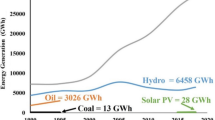Abstract—
Research results are yielded proving the great potential of renewable and alternative energy sources of the Republic of Tajikistan, including solar energy, equal to 25 billion kW h per year. The limited use of “green energy” will impose to periodic blackouts of electric consumers in the autumn-winter period. For remedy the emerging lack of energy, a more complete idea of the potential of solar energy is required. The paper provides the estimation of the energy potential of solar radiation in the Pamir regions and the south of Tajikistan. The mathematical model for definition of maximum value of the azimuth angle for the Pamir region is presented. Expressions for an assessment of functioning of two systems and increments of solar radiation and energy potential, by taking into account duration of daylight are offered. Measurements and calculations of monthly, seasonal and annual levels of solar radiation were performed based on the use of two technical systems. It was shown that the energy efficiency of the dual axis solar tracker (DAST) significantly exceeds the efficiency of the static solar system (SSS) especially in the autumn, spring and summer seasons. A comparative analysis of solar energy production and the efficiency of two systems with the use of a solar tracker for a biaxial tracking system and a fixed system is given. It is shown that the annual productivity of the DAST compared with the SSS is on average by 30% higher. In the autumn, the movable system can generate 80% more energy relative to the stationary arrangement of solar panels. Assessment of the solar potential of the regions of Tajikistan proves the feasibility of using this potential as suitable resource for the development of energy, complementing hydrogeneration.







Similar content being viewed by others
REFERENCES
Jain, A., Mehta, R., and Mittal, S.K., Modeling impact of solar radiation onsite selection for solar PV power plants in India, Int. J.: Green Energy, 2011, pp. 486–498.
Masih, A., Thar coalfield: Sustainable development and an open sesame to the energy security of Pakistan, J. Phys.: Conf. Ser., 2018, vol. 989, id. 012004.
Fields, D., Kochnakyan, A., Suggins, G., and Besant-Jones, J., Tajikistan’s Winter Energy Crisis: Electricity Supply and Demand Alternatives, Washington, DC: World Bank, 2013, pp. 4–5.
Roong, A.S.C. and Chong, S.-H., Laboratory-scale single axis solar tracking system: Design and implementation, Int. J. Power Electron. Drive Syst., 2016, pp. 254–264.
Basnayake, B., Jayathilaka, W., Amarasinghe, Y., et al., Smart solar tracking and on-site photovoltaic efficiency measurement system, Moratuwa Eng. Res. Conf. (MERCon), 2016, pp. 54–59.
Soon, A.C.R., Chong, S.-H., and Gan, C.K., Design and implementation of a laboratory-scale single axis solar tracking system, Proc. 1st ICRIL Int. Conf. on Innovation in Science and Technololgy (IICIST), Kuala Lumpur, Malaysia, 2015, pp. 645–648.
Singh, G.K., Solar power generation by PV (photovoltaic) technology, Energy, 2013, vol. 53, pp. 1–13.
Rizk, J. and Chaiko, Y., Solar tracking system: more efficient use of solar panels, World Acad. Sci., Eng. Technol., 2008, vol. 41, pp. 313–315.
Khalifa, A.J.N. and Al-Mutawalli, S.S., Effect of two-axis sun tracking on the performance of compound parabolic concentrators, Energy Convers. Manage., 1998, vol. 39, pp. 1073–1079.
Bakos, G.C., Design and construction of a two-axis Sun tracking system for parabolic trough collector (PTC) efficiency improvement, Renewable Energy, 2006, vol. 31, pp. 2411–2421.
Abdallah, S. and Nijmeh, S., Two axes sun tracking system with PLC control, Energy Convers. Manage., 2004, vol. 45, pp. 1931–1939.
Alexandru, C. and Comsit, M., The energy balance of the photovoltaic tracking systems using virtual prototyping platform, EEM2008: 5th Int. Conf. on European Electricity Market, 2008, pp. 1–6.
Al-Mohamad, A., Efficiency improvements of photo-voltaic panels using a Sun-tracking system, Appl. Energy, 2004, vol. 79, pp. 345–354.
Karimov, K.S., Saqib, M.A., Akhter, P., et al., A simple photo-voltaic tracking system, Sol. Energy Mater. Sol. Cells, 2005, vol. 87, pp. 49–59.
Cruz-Peragon, F., Casanova-Pelaez, P.J., Diaz, F.A., et al., An approach to evaluate the energy advantage of two axes solar tracking systems in Spain, Appl. Energy, 2011, pp. 5131–5142.
Khatib, T., Mohamed, A., and Sopian, K., Optimization of the tilt angle of solar panels for Malaysia, Energy Sources, Part A: Recovery, Util. Environ. Effects, 2015, vol. 37, no. 6, pp. 606–613.
Zakirullin, R., Optimized angular selective filtering of direct solar radiation, Appl. Sol. Energy, 2019, vol. 55, no. 1, pp. 48–56.
Ayodele, T.R. and Ogunjuyigbe, A.S.O., Prediction of monthly average global solar radiation based on statistical distribution of clearness index, Energy, 2015, vol. 90, pp. 1733–1742.
Chabanea, F., Guellaia, F., Michraouib, M.-Y., et al., Prediction of the global solar radiation on inclined area, Appl. Sol. Energy, 2019, vol. 55, no. 1, pp. 41–47.
Lubitz, W.D., Effect of manual tilt adjustments on incident irradiance on fixed and tracking solar panels, Appl. Energy, 2011, vol. 88, pp. 1710–1719.
Mousazadeh, H., Keyhani, A., Javadi, A., et al., A review of principle and sun-tracking methods for maximizing solar systems output, Renewable Sustainable Energy Rev., 2009, vol. 13, pp. 1800–1818.
Duffie, J.A. and Beckman, W.A., Solar Engineering of Thermal Processes, Hoboken, New Jersey: Wiley, 2013, 4th ed.
ACKNOWLEDGMENTS
The reported study was funded by RFBR, project number 19-38-90204.
Author information
Authors and Affiliations
Corresponding author
About this article
Cite this article
Safaraliev, M.K., Odinaev, I.N., Ahyoev, J.S. et al. Energy Potential Estimation of the Region’s Solar Radiation Using a Solar Tracker. Appl. Sol. Energy 56, 270–275 (2020). https://doi.org/10.3103/S0003701X20040118
Received:
Revised:
Accepted:
Published:
Issue Date:
DOI: https://doi.org/10.3103/S0003701X20040118




